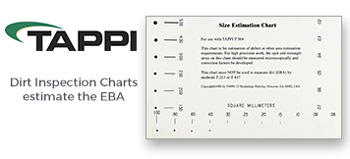 Search
Search
Use the search bar or filters below to find any TAPPI product or publication.
Filters
Content Type
Publications
Level of Knowledge
Committees
Collections
Journal articles

Magazine articles

Application of spruce wood flour as a cellulosic-based wood additive for recycled paper applications— A pilot paper machine study, TAPPI Journal October 2021
ABSTRACT: This study gives a first insight into the use of wood flour as a plant-based and cellulosic-based alter-native additive for newsprint and paperboard production using 100% recycled fibers as a raw material. The study compares four varieties of a spruce wood flour product serving as cellulosic-based additives at addition rates of 2%, 4%, and 6% during operation of a 12-in. laboratory pilot paper machine. Strength properties of the produced news-print and linerboard products were analyzed. Results suggested that spruce wood flour as a cellulosic-based additive represents a promising approach for improving physical properties of paper and linerboard products made from 100% recycled fiber content. This study shows that wood flour pretreated with a plant-based polysaccharide and untreated spruce wood flour product with a particle size range of 20 μm to 40 μm and 40 μm to 70 μm can increase the bulk and tensile properties in newsprint and linerboard applications.
Journal articles

Magazine articles

Evaluation of soap recovery efficiency from black liquor — analytical tools, TAPPI Journal April 2023
ABSTRACT: Soap skimmings (“soap”) are typically recovered from black liquor in kraft mills that process a high percentage of softwood. In many mills, the recovery of soap is inefficient, negatively impacting performance of evaporators and recovery boilers and resulting in loss of potential revenue. A thorough evaluation of soap recovery performance in a kraft mill requires measurement of soap content in black liquor at various sampling locations, especially around the soap skimmer.The standard laboratory method for evaluating soap content in black liquor is a complex, multi-step process that relies on solvent extraction and titration; most mills send these samples to an outside laboratory for this analysis. In this study, 100 black liquor samples, with a wide range of soap concentrations, were tested by the standard solvent extraction method. After additional dilution, each sample was also tested for surface tension with a bubble pressure tensiometer. The results were found to correlate very closely with the solvent extraction tests results. This alternate method, using surface tension measurements of diluted black liquor samples, produces rapid results and can be easily implemented in most kraft mills, which would facilitate much more frequent in-house evaluations of soap recovery performance.
Journal articles

Magazine articles

Value creation by converting pulp mill flue gas streams to green fuels, TAPPI Journal March 2023
ABSTRACT: Climate change mitigation induces strong growth in renewable electricity production, partly driven by shifts in environmental policies and regulation. Intermittent renewable electricity requires supporting systems in the form of sustainable hydrocarbon chemicals such as transportation fuels. Bulk chemical production fits well into a pulp mill environment, given their large volumes, stable operation, and ample supply of biomass-based carbon feed-stock in the form of flue gases. Until now, the utilization of the flue gases from conventional operation of a pulp mill has received little attention. Harnessing these flue gases into usable products could offer additional value to mill operators, while also diversifying their product portfolio. However, electricity-based fuels and products require extra energy in the conversion step and may not be commercially competitive with current fossil products under the current regulation. There might also be uncertainties about future commodity prices. Thus, the objective of this study is to estimate the economic competitiveness and the added value of selected side products that could be produced alongside conventional pulp and paper products. A typical modern pulp mill is modeled in different product configurations and operational environments, which allows testing of various development paths. This illustrates how the overall energy and mass balance of a pulp mill would react to changes in different final products and other parameters. The focus of the study is in synthetic methanol, which is produced from flue gases and excess resources from the mill, with minimal interference to the pulping process. The results aid in assessing the necessity and magnitude of a premium payment for subsidizing green alter-natives to replace current fossil fuels and chemicals. Additionally, the results function as an indicator of the development state of the pulp and paper industry in the turmoil of climate change regulation. The results indicate that power-to-X systems offer one more viable pathway alternative for broadening the product portfolio of the pulp and paper sector, as well as opening new flexibility measures and services to grid stabilization. Market conditions were found to have a significant impact on the perceived profitability.
Journal articles

Magazine articles

Application of ATR-IR measurements to predict the deinking efficiency of UV-cured inks, TAPPI Journal January 2022
ABSTRACT: In recent years, ultraviolet (UV)-curable ink has been developed and widely used in various printing applications. However, using UV-printed products (UV prints) in recovered paper recycling causes end-product dirt specks and quality issues. A new method was developed that can distinguish UV prints from other prints by means of attenuated total reflectance infrared (ATR-IR) spectroscopy. Application of this method could allow more efficient use of UV prints as raw materials for paper recycling.First, a mill trial was performed using UV prints alone as raw materials in a deinked pulp (DIP) process. Second, test prints were made with four types of UV inks: a conventional UV ink and three different highly-sensitive UV inks. Each print sample had four levels of four-color ink coverage patterns (100%, 75%, 50%, and 25%). Next, deinkability of all prints was evaluated by laboratory experiments. Finally, each print was measured using the ATR-IR method, and the relationship between the IR spectra and deinkability was investigated. Mill trial results showed that UV prints caused more than 20 times as many dirt specks as those printed with conventional oil-based ink. There were variations in recycling performance among UV prints taken from bales used for the mill trial. Lab tests clearly revealed that not all UV-printed products lead to dirt specks. In order to clarify the factors that affected deinkability of UV prints, the print samples were investigated by lab experiments. Key findings from lab experiments include: • The number of dirt specks larger than 250 µm in diameter increased as the ink coverage increased. • Higher ink coverage area showed stronger intensity of ATR-IR spectral bands associated with inks. These results indicate that deinkability of UV prints could be predicted by analysis of ATR-IR spectra. • Finally, the method was applied for assessment of recovered paper from commercial printing presses. It was confirmed that this method made it possible to distinguish easily deinkable UV prints from other UV prints. Based on these findings, we concluded that the ATR-IR method is applicable for inspection of incoming recovered paper.





